7 Most Beautiful Churches in London You Must See
11 min readLondon, a city rich in history and architectural splendour, is home to some of the most beautiful and historically significant churches in the world. From iconic cathedrals to hidden gems,...
The post 7 Most Beautiful Churches in London You Must See appeared first on Timeless Travel Steps.
London, a city rich in history and architectural splendour, is home to some of the most beautiful and historically significant churches in the world. From iconic cathedrals to hidden gems, these sacred spaces offer a glimpse into the city’s past, as well as its architectural and artistic heritage.
I have visited each one mentioned in this post, and each time, I was captivated by their unique charm and the depth of history that pervades each site. I have here, specifically selected, seven of the most beautiful churches, cathedrals, and chapels in London, each with its unique features which I think make them worth visiting.
Timeless Travel Steps is supported by our readers. If you purchase through an affiliate link on my site, at no cost to you, I may earn a commission from qualifying purchases. Please read our Disclosure for further information.
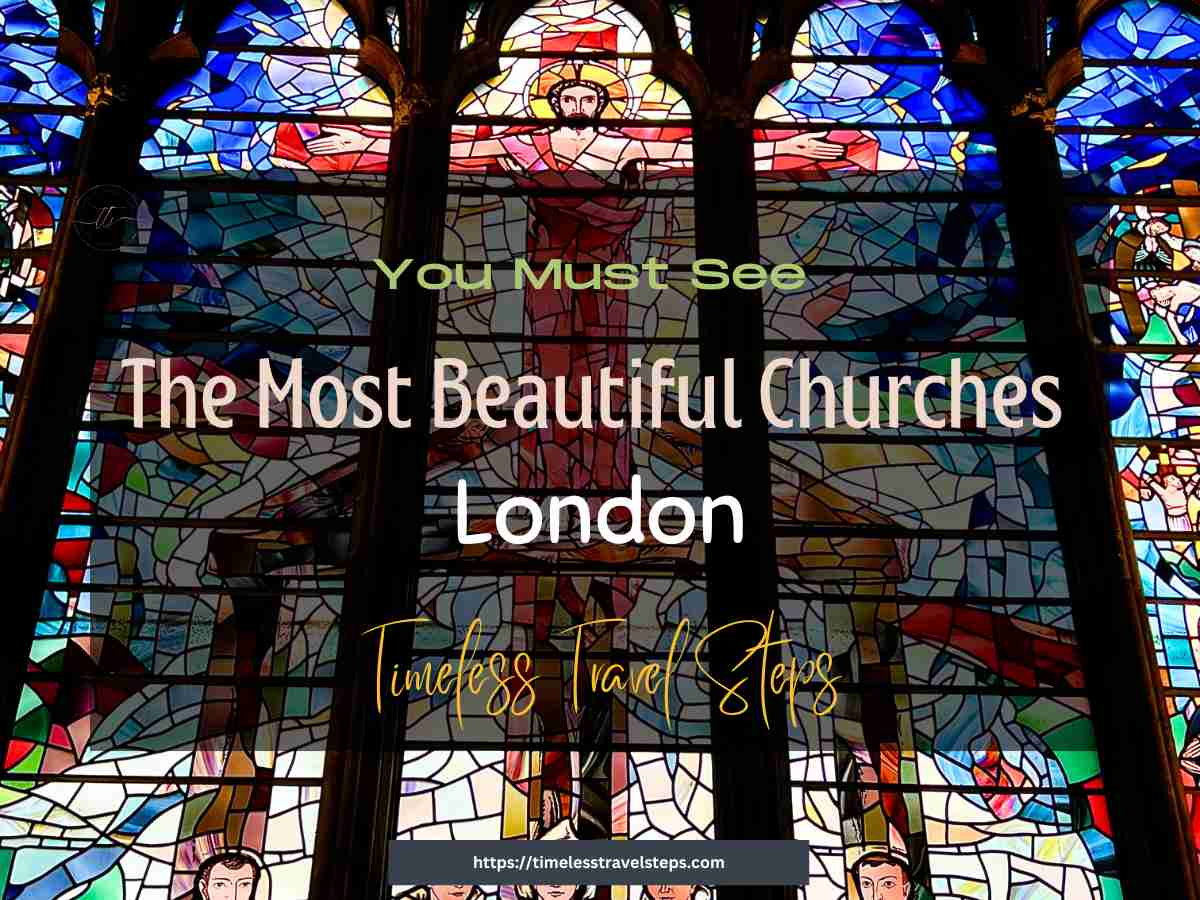
Most beautiful churches to visit in London
Here are seven of the prettiest churches, cathedrals, and chapels you’ll love in London:
St Paul’s Cathedral
The iconic St Paul’s Cathedral, London, needs no introduction! Attracting about 1.5 million visitors each year, this exemplary architecture stands out as it is part of the city’s defining landmark and has played key roles in historic events such as royal weddings, state funerals, and national services.
In addition, St. Paul’s Cathedral has a storied past, with the original church on the site dating back to 604 AD. This early wooden structure was replaced by a Norman cathedral in 1087, which was eventually destroyed by fire in 1666 during the Great Fire of London. The current St. Paul’s, designed by Sir Christopher Wren, was part of a major rebuilding program after the Great Fire. Wren’s masterpiece took 35 years to complete and has since been a central landmark in London.
Some may consider the entry fee to be a little hefty. However, St. Paul’s Cathedral is unique and is one of the most beautiful churches in London not to miss. The magnificent dome, which dominates the London skyline is a marvellous sight seen from the inside, featuring exquisite mosaics, and intricate frescoes. This dome, the second largest in the world, stands at 111 meters high and has been a symbol of resilience and hope, particularly during the Blitz of World War II when it survived bombing raids.
The interior of the cathedral is equally breathtaking, with its ornate mosaics, intricate woodwork, and the awe-inspiring Whispering Gallery, where a whisper against the wall can be heard clearly on the opposite side. You’ll also have the chance to visit the recently restored hidden library and the geometric staircase, made of 88 Portland stone, dates back 300 years!
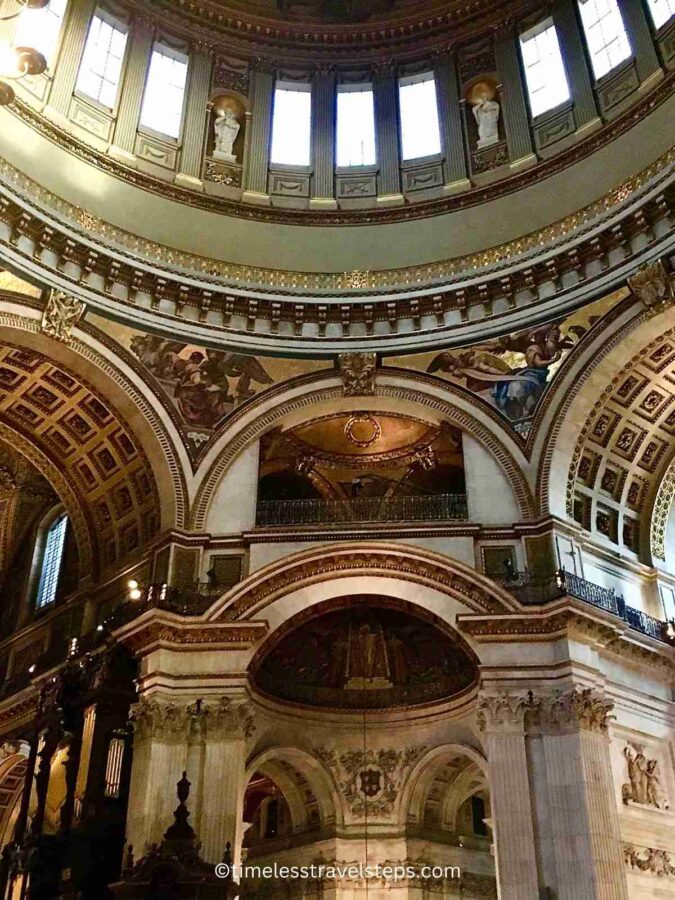
Helpful Information
- Built: First known in 604 AD. The current building was constructed between 1675 and 1710.
- Denomination: Church of England
- Architectural Style: English Baroque
- Entry fee applies.
- Opening Hours: Monday to Saturday, 8:30 AM – 4:30 PM; Tours: Available daily
- Address: St. Paul’s Churchyard, London EC4M 8AD
- Nearest Station: St. Paul’s (Central Line)
- Official website.
Westminster Abbey
Known as the royal church, this extraordinarily beautiful church draws on almost 1.2 million visitors each year, Westminster Abbey has been at the heart of British history for over a thousand years. Founded by Benedictine monks in 960 AD, the Abbey was rebuilt in Gothic style by Henry III in the mid-13th century.
Since the coronation of William the Conqueror in 1066, it has been the traditional site for the coronation of British monarchs. It has also been the venue for numerous royal weddings, including the marriage of Prince William to Catherine Middleton in 2011. The Abbey houses the tombs of many of the nation’s greatest kings, queens, and cultural figures, making it a living pageant of British history.
The tomb of King Edward the Confessor can be found just behind the high altar. Queen Elizabeth I and Queen Mary I are laid together in the Lady Chapel.
The Abbey’s stunning architecture includes the famous Coronation Chair, Poet’s Corner where many literary greats are remembered, and the exquisite Lady Chapel with its fan-vaulted ceiling and beautiful stained glass windows.
For an additional fee, you can access the Golden Jubilee Galleries, which are located high above the Abbey floor in the triforium. This gallery offers spectacular views of the Abbey and displays a range of treasures from the Abbey’s collection.
The Abbey’s rich history, stunning architecture, and cultural significance make it one of the most visited landmarks in London.
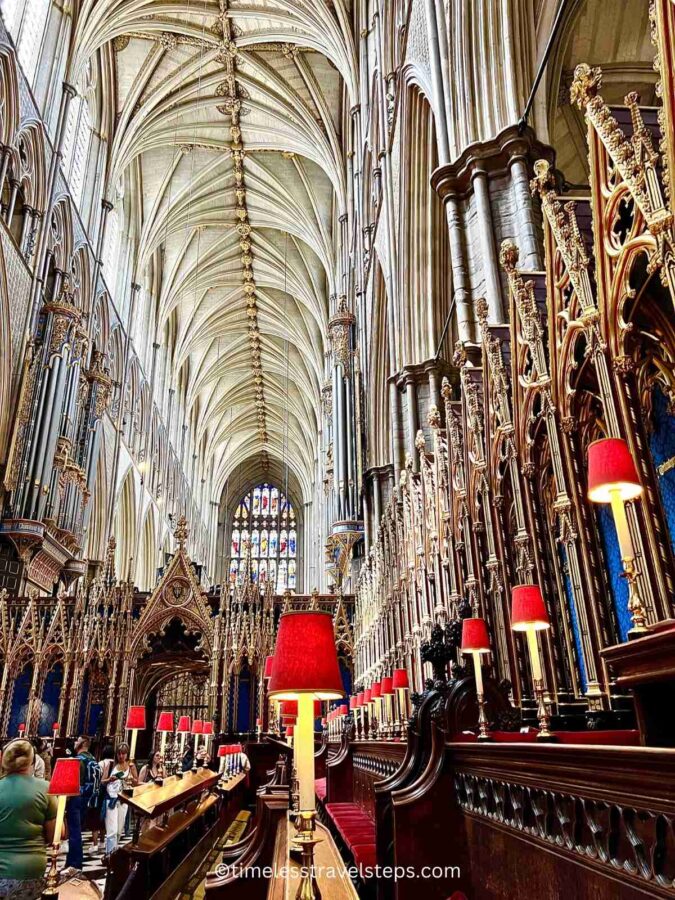
Helpful Information
- Built: Founded in 960 AD. The current structure begun in 1245.
- Denomination: Church of England.
- Architectural Style: Gothic.
- Entry fee applies.
- Opening Hours: Monday to Saturday, 9:30 AM – 3:30 PM (varies seasonally). Closed for visits on Sundays and religious holidays. Tours: Available; audio guides included with admission. Guided tours can be booked in advance.
- Address: 20 Deans Yard, London SW1P 3PA.
- Nearest Station: Westminster (Jubilee, District, and Circle Lines).
- Official website.
The Chapel of St Peter and St Paul, Greenwich
The Chapel of St Peter and St Paul is indeed one of the most beautiful churches that I have seen! Quaint, serene, bright and airy, this pretty chapel is situated within the grounds of the Old Royal Naval College, boasting beautiful frescoes and impressive architecture.
The chapel attracts numerous visitors each year who come to admire its serene beauty and historic significance. Its neoclassical design and stunning location within the UNESCO World Heritage Site of Maritime Greenwich.
The Chapel of St. Peter and St. Paul was constructed to serve the naval pensioners living at the Royal Hospital for Seamen, an institution founded by King William III and Queen Mary II in 1694 to provide care and accommodation for injured and retired sailors.
After a fire destroyed the original chapel in 1779, the current building was designed by Philip Hardwick and completed in 1830. The chapel’s interior is noted for its serene and uplifting atmosphere, highlighted by the magnificent altarpiece by Benjamin West, titled “St. Paul’s Shipwreck.”
Its elegant design reflects the neoclassical style of the period. The Chapel has been a place of worship and reflection for well over a century and continues to play an important role in the community’s spiritual life.
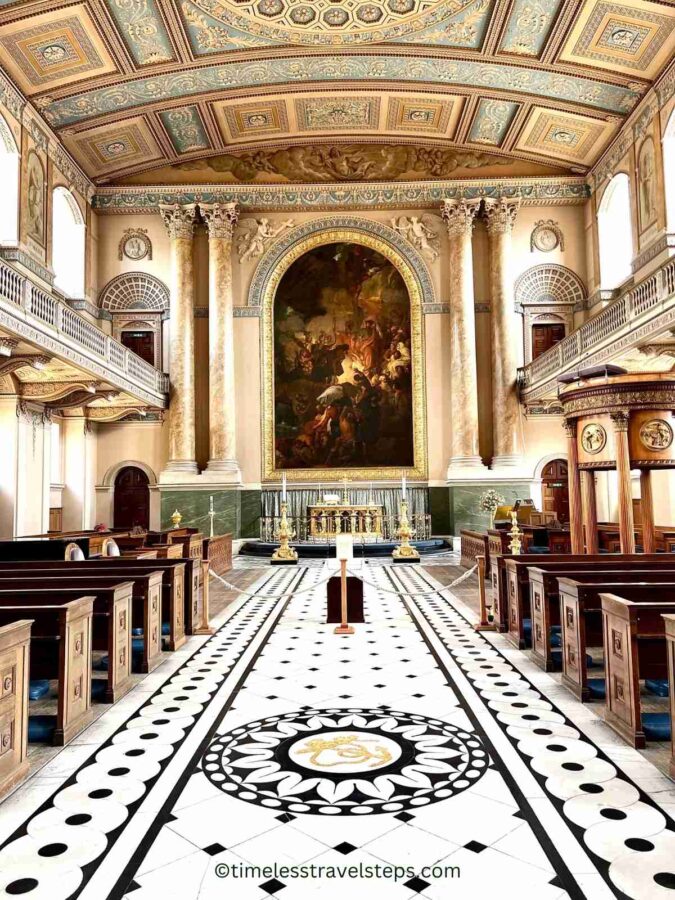
Helpful Information
- Built: 1824-1830
- Denomination: Church of England
- Architectural style: Neoclassical
- Free entry.
- Opening Hours: Daily, 10:00 AM — 5:00 PM (hours may vary due to special events).
- Tours: Guided tours are available as part of the History tour of The Old Royal Naval College, which is included in the price of the Painted Hall ticket.
- Address: Old Royal Naval College, King William Walk, Greenwich, London SE10 9NN The
- Nearest Station: Cutty Sark (DLR)
Temple Church, London
The Temple Church was built by the Knights Templar, a medieval Christian military order, and consecrated in 1185 by the Patriarch of Jerusalem. The church’s distinctive round nave, modelled after the Church of the Holy Sepulchre in Jerusalem, reflects the Templars’ Holy Land origins.
After the suppression of the Templars in the early 14th century, the church became the property of the Knights Hospitaller and later passed to the English Crown. The adjacent buildings became the centre of England’s legal profession, housing two of the four Inns of Court: Inner Temple and Middle Temple.
During the reign of Henry VIII, the church played a significant role as the king took control of the property from the religious orders. The church was extensively restored by Sir Christopher Wren in the 17th century after it had fallen into disrepair. In the 20th century, it was heavily damaged during the Blitz of World War II but was carefully restored to its former glory.
Temple Church’s interior is different and especially beautiful. A rare architectural feature, built by the Knights Templar is its beautiful 12th-century Round Church and the later Gothic Chancel.
The Round Church, popularly regarded as London’s Jerusalem contains the effigy tombs of medieval knights, including notable Templars. William Marshall, 1st Earl of Pembroke, mostly regarded as the greatest hero of his time was buried here in 1219, and his effigy can be seen today. The church has also been associated with the Magna Carta, as the Templars played a role in the negotiations leading to its sealing in 1215, and the birthplace of American Law.
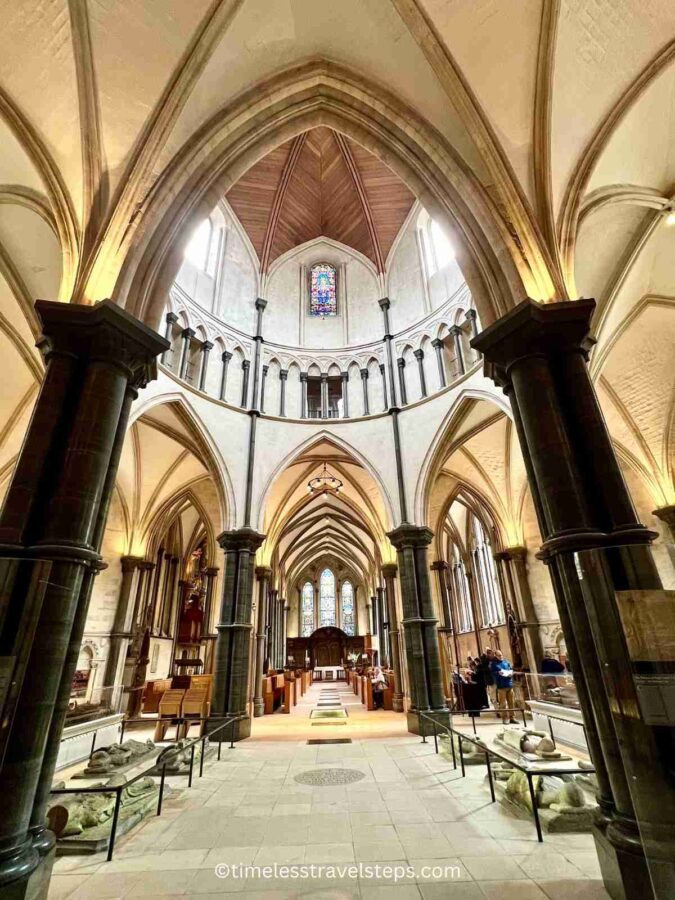
Helpful Information
- Built: Consecrated in 1185.
- Denomination: Church of England.
- Architectural Style: Romanesque and Gothic.
- A small entry fee applies.
- Opening Hours: Monday to Friday, 10:00 AM – 4:00 PM; occasional closures for private events.
- Tours: Guided tours are available and can be booked in advance.
- Address: Temple, London EC4Y 7BB
- Nearest Station: Temple (District and Circle Lines)
- Official website.
St Mary le Strand
St. Mary le Strand has a rich history dating back to the 12th century. The current church was one of the first built under the Commission for Building Fifty New Churches, an initiative of Queen Anne aimed at providing places of worship for London’s growing population.
The church was designed by James Gibbs, a leading architect of the time, who was also responsible for St. Martin-in-the-Fields. It was built on the site of an earlier 12th-century church dedicated to the same saint, which had fallen into disrepair and was eventually demolished. The new church was consecrated in 1723 and quickly became known for its distinctive Baroque style, characterized by elaborate decorations, grand columns, and a beautifully detailed facade.
Over the centuries, it has witnessed the changing landscape of London, standing as a testament to the city’s architectural evolution. Its location is notably close to King’s College London, one of the most prestigious universities in the world, and Somerset House, a major arts and cultural center.
The Church of St. Mary le Strand reflects a deep connection to the Freemasons. Notably, the foundation stone of St. Mary le Strand was laid by Freemasons on February 23, 1714, and over the years, the church has hosted various Masonic ceremonies and events, highlighting its historical connections to the Freemason community.
I undertook a tour of St Mary le Strand. The tour, rich in information and behind-the-scenes details, allowed me to observe clear evidence of Freemason involvement, including graffiti on the walls, the use of three keys on a door and, other Masonic symbols discovered during recent renovations. I learnt of the church’s strong links to Scotland, embedded in the church’s architecture and decor.
My tour guide, Stewart Trott of The Shakespeare Code, was highly informative and dedicated. If you have the opportunity to have him as your guide, you will receive a truly insightful experience. It was an enriching experience to discover so much history in an iconic and architecturally stunning setting, located at the heart of London’s vibrant academic and cultural district. I highly encourage a visit.
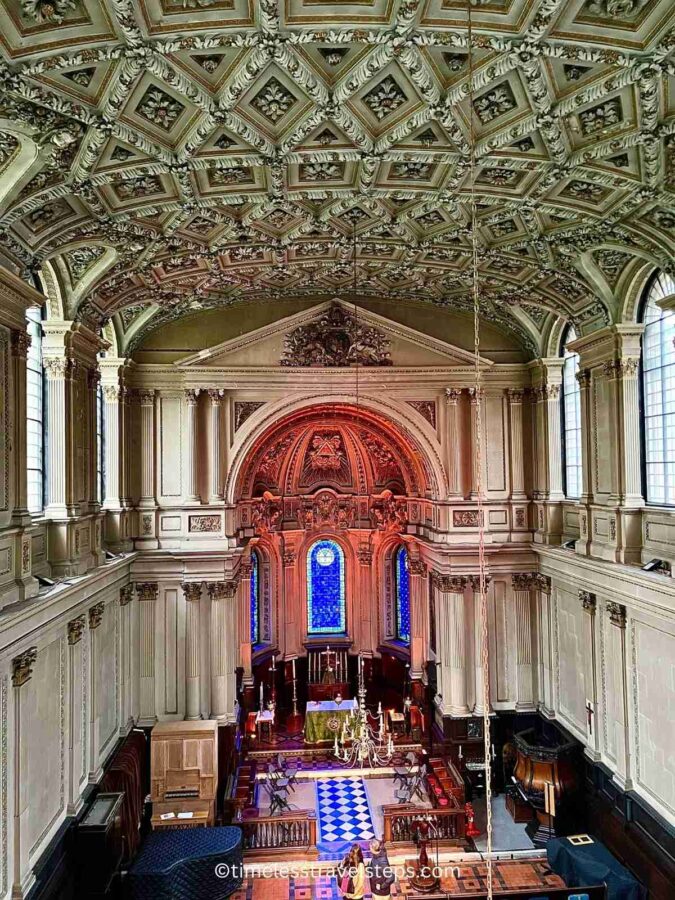
Helpful Information
- Built: 1714-1717.
- Denomination: Church of England.
- Architectural style: Baroque.
- No entry fee. Donations are encouraged.
- Opening Hours: Varies; typically open Monday to Friday, 9:00 AM – 4:00 PM (check the website for details)
- Tours: By arrangement; visitors are encouraged to contact the church for guided tour information.
- Address: Strand, London WC2R 1ES
- Nearest Station: Temple (District and Circle Lines)
- Official website.
St Etheldreda’s Church
The oldest Catholic church in the city of England, St Etheldreda is one of the most beautiful churches in London I have had the pleasure to visit and explore. A visit here and you’ll discover exquisite stained glass windows and a rich medieval heritage. The intricate craftsmanship is unique and truly beyond compare.
The church is named after St. Etheldreda, an Anglo-Saxon princess who founded a double monastery at Ely. It dates back to the 13th century when it was built as the chapel for the Bishops of Ely. The church survived the Reformation and various historical upheavals, and in 1879 it was restored to Roman Catholic worship.
St. Etheldreda retains much of its original medieval architecture, including a crypt and an upper chapel, both of which are fine examples of Gothic design. The stunning stained glass windows, installed during the Victorian restoration, depict scenes from the life of St. Etheldreda and other saints. Throughout its long history, St. Etheldreda’s has been a place of refuge and worship for many, including notable figures such as St. John Henry Newman.
It is not easy to locate St Etheldreda. Its location in Ely Place, a private road, gives it a unique and somewhat secluded atmosphere, adding to its charm and historical aura. The church is situated near Chancery Lane. You may find this map to be helpful.
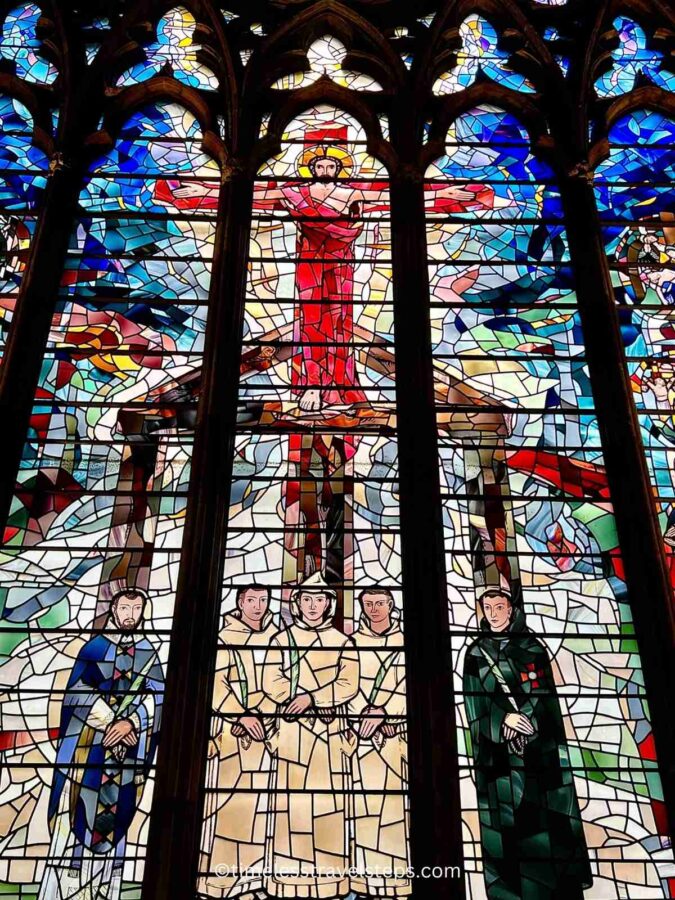
Helpful Information
- Built: 13th century.
- Denomination: Roman Catholic.
- Architectural style: Gothic.
- Free entry. Donations are encouraged.
- Opening Hours: Daily, 8:00 AM – 6:00 PM
- Tours: By arrangement; visitors are encouraged to contact the church for guided tour information.
- Address: 14 Ely Place, London EC1N 6RY
- Nearest Station: Chancery Lane (Central Line)
- Official website.
Southwark Cathedral
Southwark Cathedral, officially known as the Cathedral and Collegiate Church of St. Saviour and St. Mary Overie, stands at the oldest crossing point at River Thames and has a history that stretches back to at least the 7th century. In medieval times, it was the only entry point to the City of London. It was originally a convent, mentioned as “minster” in the Domesday Book of 1086, which later became an Augustinian priory in the 12th century.
The current Southwark Cathedral was constructed between 1220 and 1420, making it one of the oldest, exhibiting one of the most beautiful Gothic featured churches in London. Located near the vibrant Borough Market, Southwark Cathedral offers a profound and inspiring experience.
Throughout its history, Southwark Cathedral has been closely linked to the community and the development of the surrounding area. It survived the Dissolution of the Monasteries under Henry VIII and was later designated as a parish church. It achieved cathedral status in 1905.
Southwark Cathedral is notable for its associations with famous historical figures, including Geoffrey Chaucer, who referenced it in “The Canterbury Tales,” and William Shakespeare, whose brother is buried in the church. The interior of the cathedral is marked by its beautiful stained glass windows, the Harvard Chapel dedicated to John Harvard (the founder of Harvard University), and the intricate stone carvings that adorn the building.
Southwark Cathedral also had a famous resident cat named Doorkins Magnificat, who lived at the cathedral from 2008 until her passing in 2020. She had a book, a website and a Twitter account! I have had the opportunity of seeing Doorkins a couple of times during my visits and she is dearly missed by many. Doorkins Magnificat was given a special resting place within the cathedral grounds. Read about Doorkins here.

Helpful Information
- Built: 1220-1420
- Denomination: Church of England.
- Architectural style: Gothic
- Opening Hours: Daily, 8:00 AM – 6:00 PM
- Tours: Guided tours are available daily and can be booked in advance. Audio guides are also available.
- Address: London Bridge, London SE1 9DA
- Nearest Station: London Bridge (Jubilee and Northern Lines).
- Official website.
Our Top Articles about London You Might Enjoy
…in sum…which one is beautiful?
If you ask me which is the most beautiful church in London, it’s a tough call. Each one has given me immense joy in discovering their unique charm and history, making it impossible to choose just one.
St. Paul’s Cathedral with its magnificent dome and awe-inspiring interior, Westminster Abbey with its opulence and rich royal history, the Temple Church with its distinctive circular nave and medieval heritage, Southwark Cathedral with its stunning Gothic architecture and vibrant community connections, and St. Etheldreda’s with its exquisite stained glass windows and deep medieval roots—all these churches offer a unique and captivating experience. St. Mary le Strand with its intricate Baroque design and connections to Freemasonry, and St. Peter and St. Paul, Greenwich, with its neoclassical elegance and maritime heritage, add to the diversity and richness of London’s ecclesiastical landmarks.
My visits has been a journey through time, revealing the rich tapestry of London’s religious and architectural heritage. I keep discovering more, but these are my favourite so far. So, add them all, or a couple to your London list discovery, and enjoy the profound beauty and history that these churches offer.

This is I, Georgina at Temple Church, London.
Happy and safe travels, wherever travel takes you, xx
For more travel insights and tips, consider following Georgina on Instagram and Facebook. Don’t miss out on her latest adventures and expert advice. Subscribe to stay updated and join a community of fellow travel enthusiasts eager to explore the world through Georgina’s eyes.



